Menu
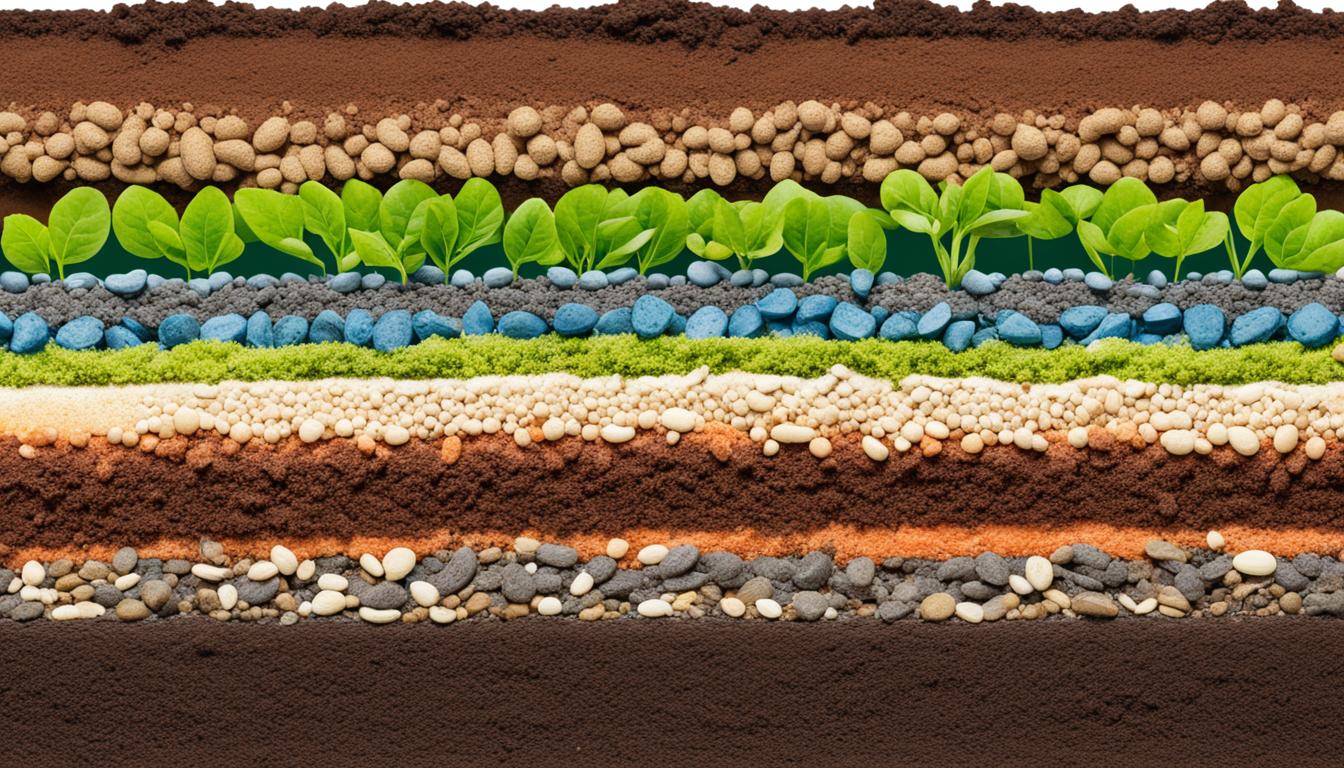
Did you know, 80% of doing well with soil nutrients relies on the “Four Rs”? This means that for agriculture to be sustainable, you must use the right amount, right source, right placement, and right timing for nutrient applications. This optimises the yield of crops and keeps the soil’s fertility high.
The USDA lays out that for farming to be sustainable, we must use nutrients like nitrogen, potassium, and phosphorous the right way. This is key because it’s good for the money and the earth. When farmers use these nutrients correctly, their crops grow better, and the soil stays healthy. They also help the environment by using less, which cuts down on waste and harm.
The goal of nutrient management is to match the nutrients given with what crops need. This helps them grow well and protects the environment. We use the Four Rs method to do this properly, which makes nutrient use efficient and reduces waste.
Managing nutrients is key for farming that can last. It makes sure plants get enough nutrients to grow without shortages. Methods like testing the soil and applying the right amount of fertiliser are essential. They help make the soil better and ensure crops grow more.
The Four Rs – right amount, source, placement, and timing – guide how we should give plants fertiliser. Following these rules helps plants use more of the nutrients and stops losses to the environment. Soil tests help spot nutrient gaps and adjust fertiliser use.
When done right, managing nutrients can make the soil richer and increase crop amounts. Conducting soil tests can show what nutrients are lacking. This allows farmers to apply the right fertilisers. Enhanced soil health also comes from adding compost and cover crops, making more nutrients available.
Summary of ‘Four Rs’ for Efficient Nutrient Management:
| Aspect | Details | Benefits |
|---|---|---|
| Right Amount | Applying the correct quantity of nutrients | Prevents over-fertilisation and nutrient runoff |
| Right Source | Using appropriate nutrient sources | Enhances nutrient uptake and efficiency |
| Right Placement | Placing nutrients where crops can access them more readily | Reduces wastage and environmental impact |
| Right Timing | Timing nutrient application for maximum absorption | Improves crop yield and reduces loss to environment |
Soil health is vital for good farming. It helps the soil be more fertile and grow better crops. It all starts with testing the soil and looking closely at certain signs of soil health.
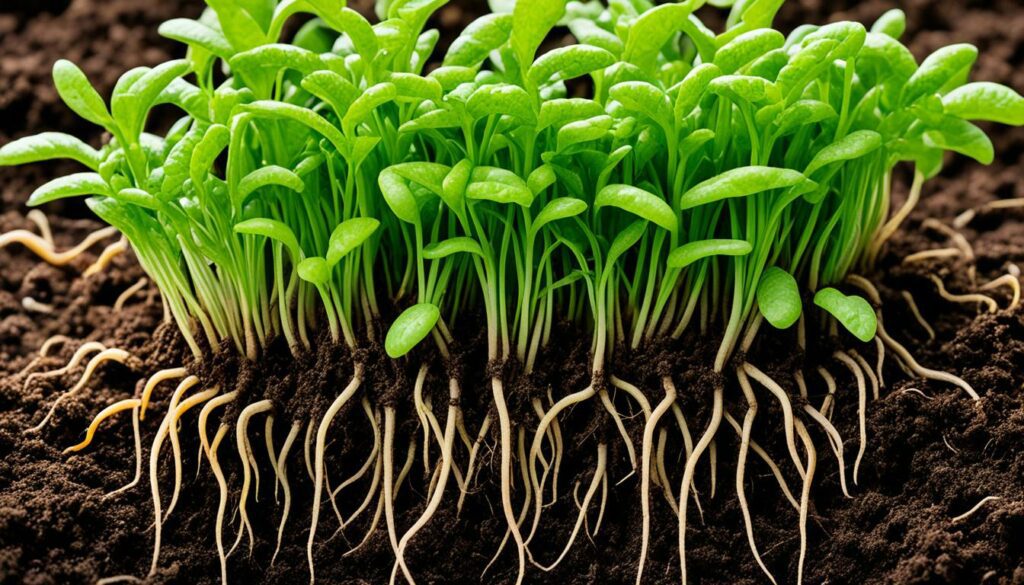
There are many ways to test the soil, whether done by professionals or at home. These tests tell us about the soil’s nutrients and how it’s built. They help us find what nutrients are lacking, like nitrogen, potassium, and phosphorus. Knowing this, farmers can improve how they give nutrients to the soil and make it healthier.
Important signs of soil health include how well it holds water, its acidity, and if there’s organic matter. Soil that’s 4% organic matter can hold about 4,000 lbs of nitrogen per acre, for example. Increasing organic matter can make soil better in many ways. It can make the soil’s texture and structure improve. It also balances chemicals in the soil and supports various tiny soil creatures.
Adding manure can add between 20 to 40 lbs of nitrogen per acre, based on the amount of organic matter. Certain plants, like alfalfa and red clover, can help the next crops by adding 60 to 150 lbs of nitrogen.
Soil organic matter usually contains over 90% of all soil nitrogen. This high number shows us how important it is to increase organic matter. Using cover crops, compost, and manure can increase organic matter and make more nutrients available without using lots of chemical fertilisers.
Keeping soil rich in nutrients is vital for farming that will last long. It boosts soil health and helps crops grow better. To do this right, farmers make a plan. They set how much nutrient their crops need and figure out where to get them.
A nutrient budget is key for good soil care. It matches what crops need with what they get. Farmers look at different nutrient sources, like compost and manure.
Now, the NRCS is giving out $19.5 billion to push for greener farming. This helps farmers take better care of their soil. It also shows how saving nutrients can help save money.
Finding the right sources for nutrients is crucial. Both natural and bought fertilisers help keep the soil healthy. When choosing, farmers think about the type of soil and other details. They may also check the nutrients in the soil directly.
In Pennsylvania, tests on manure show big differences in nutrients. Sometimes, what’s written in the books is not what’s really there. So, farmers must test the manure and use the results to decide how much to use.
“Efficient nutrient management saves money and boosts harvests. Planning doesn’t have to cost a lot. Everyone can do it.”
Plants like hay or corn need more nutrients. How manure is used also matters. If it’s mixed with the soil right away, it helps more. Waiting to mix it, not so much.
| Practice | Objective | Impact |
|---|---|---|
| Immediate Incorporation of Manure | Maximise nutrient availability | 50% nitrogen readily available |
| Delayed Manure Incorporation | Minimise nutrient losses | 20% nitrogen availability if left unincorporated for a week |
| Soil Conservation Practices | Minimise environmental impact | Reduces excess phosphorus and potassium applications |
Protecting the soil helps stop too much phosphorus and potassium ending up in the environment. Farming smart means looking at the nutrients you have and what your crops really need. This way, you avoid waste and do better for your land.
It’s key to understand soil fertility for strong crop growth. Good soil fertility means the right mix of nutrients, good soil structure, enough organic material, and perfect pH levels. Making sure these are in balance helps farms be both productive and kind to the environment.
Plants need 17 nutrients to grow. They get 14 from the soil and 3 from the air and water. The main ones are nitrogen, phosphorus, potassium, calcium, magnesium, and sulphur. Keeping the soil healthy is vital for plants to take in these nutrients well.
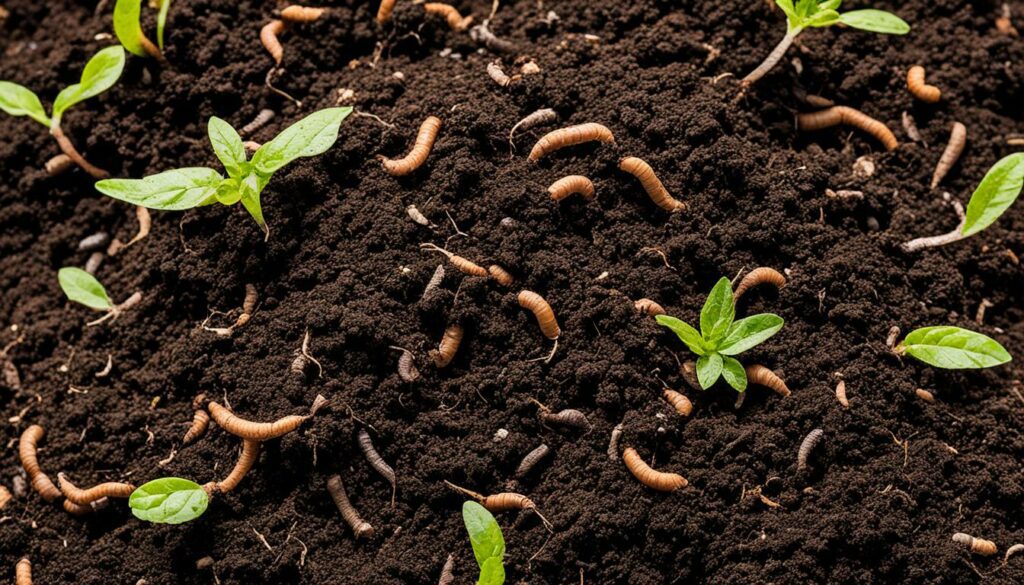
Iron, manganese, zinc, boron, copper, molybdenum, and chlorine are also crucial, showing specific signs when lacking. Managing soil fertility aims to grow crops well without harming the environment. Careful nutrient management through soil tests for specific crops is key.
In Hawaii, soil breaks down quickly due to warm, wet weather. This leads to lower fertility. To combat this, using organic waste like tankage and vermicompost helps a lot. Applying fertilizers in two or more times can also stop nutrients from washing away.
Giving the right care to soil fertility and nutrient uptake is important for sustainable agriculture.
A good plan for using nutrients helps soil stay fertile and plants grow strong. Below is a table that shows what each essential plant nutrient does.
| Nutrient | Source | Role | Deficiency Symptoms |
|---|---|---|---|
| Nitrogen | Soil | Protein synthesis | Yellowing of leaves, stunted growth |
| Phosphorus | Soil | Energy transfer | Dark green/reddish leaves, stunted plants |
| Potassium | Soil | Water regulation | Wilting, burn marks on leaves |
| Calcium | Soil | Cell wall structure | Distorted fruits, necrosis near base |
| Magnesium | Soil | Chlorophyll formation | Yellowing/browning of older leaves |
Shortage of nutrients can really hurt plants and lessen their output. Knowing the signs of certain nutrients lacking helps us fix things.
When plants lack phosphorus, they appear in a dark green colour with hints of purple, bronze, or red. They may not grow as tall and have brown marks on their leaves. Checking the soil regularly helps find and fix phosphorus problems early to support strong, healthy plants.
Not enough potassium makes plant leaf edges go brown or burnt. There’s also yellowing between leaf veins and purple spots. The growth becomes slow too. Correcting this issue is important for sturdy stems and plant vitality. Using the right fertilisation, based on soil tests, can improve potassium levels.
Knowing how to spot and treat nutrient shortages, like nitrogen, phosphorus, and potassium, is key for good soil and strong crops. Regular soil testing is crucial to catch and fix these issues soon.
| Nutrient Deficiency | Symptoms |
|---|---|
| Nitrogen Deficiency | Yellowing lower leaves, pale green upper leaves, weak branches, reduced crop yield |
| Phosphorus Deficiency | Dark green leaves with purple, bronze, or red tinges, stunted growth, brown spots, necrosis |
| Potassium Deficiency | Brown or burnt-looking leaf edges, chlorosis between leaf veins, purple spots on leaves, slow growth |
Getting soil pH just right is key for growing good crops. The pH of soil affects which nutrients plants can use and how well the soil supports life. There are many ways to change soil pH to suit different crops.
To aim for a perfect soil pH of 6.0 to 7.5, farmers can use different things. They might add lime, like hydrated or pelletised lime, to make soil less acidic. Hydrated lime works fast with a ‘neutralising value’ of 120 to 135. In some places, marls can help by adding 70 to 90 percent more base to the soil. Oyster shells are great for soils that are a bit acidic, with a value of 90 to 110.
If the soil needs to be more acidic, materials like aluminium sulphate or sulphur can be used. Aluminium sulphate works quickly, while sulphur is slower but effective. Fluid lime, which is half water and half fine limestone, also works fast but needs more used to see results.
The right soil pH is vital for getting the most from fertilisers and for healthy plants. At the best pH, plants can easily use important nutrients. However, too much acidity can make some nutrients harmful, which is bad for the crops.
Nutrients in the soil change with the pH. Soil that’s too alkaline can stop plants from getting enough phosphorus and other key nutrients. That’s why it’s so important to keep soil pH just right. This helps plants get the nutrients they need, and grow big and strong.
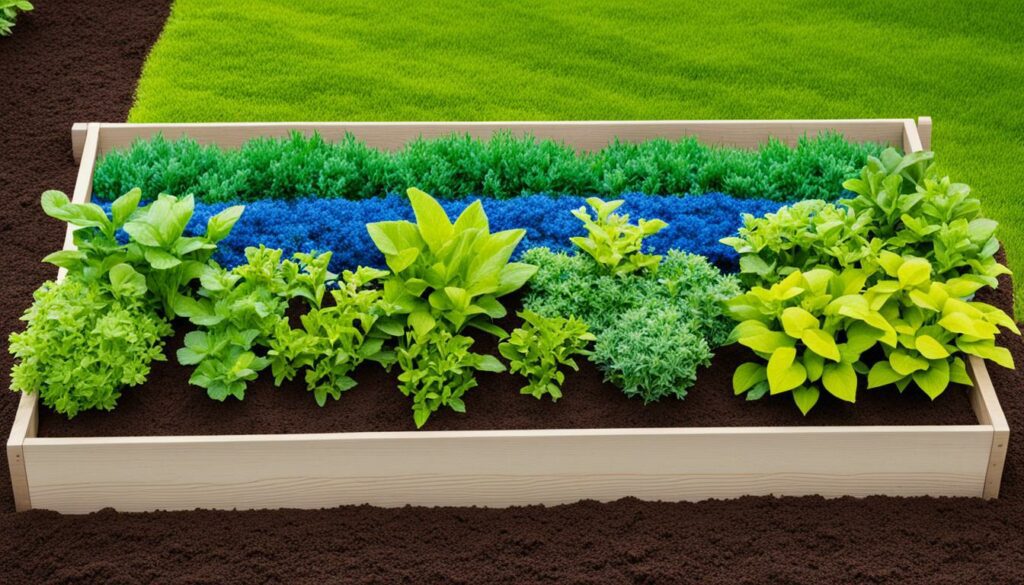
| Amendment | Neutralising Value | Effectiveness |
|---|---|---|
| Hydrated Lime | 120 to 135 | Fast-Acting |
| Marls | 70 to 90 | Moderate |
| Fluid Lime | NA | Quick but requires higher application rate |
| Oyster Shells | 90 to 110 | Effective |
Balancing soil acidity is crucial for good farming. For example, if you use a pound of ammonium nitrogen, you’ll need 1.8 pounds of pure calcium carbonate to fix the soil. By managing soil pH carefully, you make sure plants get what they need. This leads to better soil and healthier crops.
Choosing the correct fertilisers is key to better soil health and nutrient absorption. You face a choice between organic and chemical fertilisers. This choice can greatly impact soil fertility and how well your crops grow.
Organic choices, like compost and manure, are great for the soil. They make the soil better and help good bacteria grow. They release nutrients slowly, which is good for plants. But, they may cost more and have less nutrients in them than chemical fertilisers.
Chemical fertilisers give plants nutrients quickly and accurately. They are rich in key elements like nitrogen, phosphorus, and potassium for plant growth. They might be cheaper per nutrient, but their runoff can harm the environment. Overusing them can also damage the soil’s natural balance.
To pick the best fertiliser, you need to know what your crops and soil need. Different plants need different nutrients at various times. For example, most fruits and vegetables like soil that’s not too acidic. This choice affects how well plants can use the nutrients.
The type of soil you have is also crucial. Clay and rich earth hold onto nutrients well. Sandy soil, on the other hand, might need more attention. You can learn a lot from soil tests. They show what your soil lacks and help you choose the right fertiliser.
Farming in a way that’s good for the earth and your profits is important. Using organic fertilisers when you can is a smart, long-term move. But, smart use of chemical fertilisers, sticking to the “Four Rs,” can also grow healthy crops and protect the environment.
| Nutrient Source | Benefits | Considerations |
|---|---|---|
| Organic Fertilisers | Improves soil structure, promotes microbial activity, slow-release | Higher cost, lower nutrient concentration, variable nutrient content |
| Chemical Fertilisers | Precise nutrient management, rapid nutrient delivery, more cost-effective | Higher risk of runoff, potential soil microbiome disruption, higher burn potential |
Managing soil nutrients well is key for growing various crops and sustainable farming. Each crop needs different nutrients and responds to soil in its own way. Knowing this helps farmers boost crop yields and keep the soil healthy for the long run.
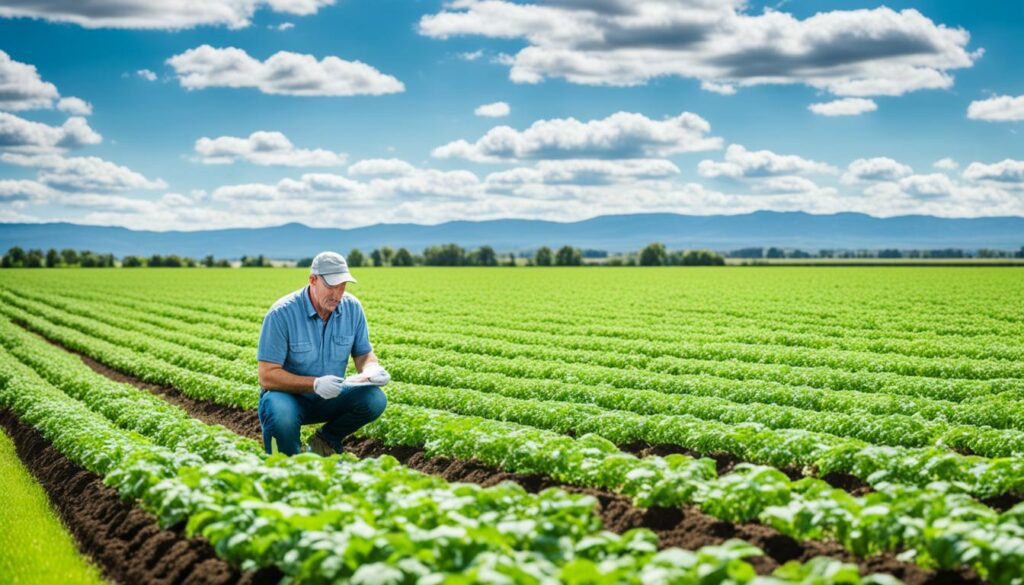
Farmers aim to make the soil more fertile and meet crops’ nutrient needs. They follow the “Four Rs” to use the right amount of nutrients in the right way. This method helps reduce harm to the environment caused by excess nutrients like nitrogen, potassium, and phosphorus.
Testing the soil is crucial in planning how to provide the best nutrients for crops. It helps choose the best management plans for better yields and profit. The UC Sustainable Agriculture Research and Education Program and UC Cooperative Extension offer great advice. For example, they have guides like the UC Cooperative Extension Small Farm Program’s Guide for Fertilizing Vegetables.
Ideal soil for plants is about half solids, rich in minerals and organic matter. When organic matter breaks down, it gives off nitrogen, making the soil healthier. This also boosts the soil’s ability to hold nutrients and water. So, understanding soil’s nutrient flow is vital for long-lasting, successful farming.
By knowing about soil nutrients, farmers can grow crops better without harming the soil. They can manage nutrients wisely for each crop, which improves yield and saves the soil. So, using the right methods for soil nutrient management is crucial for farming’s future.
Good soil health is key for successful farming that doesn’t harm the environment. Adding organic matter to the soil is crucial for this. It comes from living things, leftover plants, things breaking down, and solid stuff. These elements boost the soil’s health. Soils with 3.0-3.5% organic matter give better crops and are eco-friendly.
Compost and manure are key for making soil more fertile. They keep important nutrients like nitrogen in the soil longer. Just 1% more organic matter can add 10-20 pounds of nitrogen per acre each year. They also make the soil full of life and help it stay strong. This is very important for farming that lasts and doesn’t harm the environment.
Cover crops are a big help in keeping soil healthy. They cover the soil, stopping it from washing away and making rain go in better. This means less soil is lost to water, by as much as 33%. When they break down, they add nutrients to the soil and keep it lively. This is vital for a healthy farm.
It’s a good idea to use things like compost, manure, and cover crops. They’ll make your farm’s soil and crops healthier.
| Component | Organic Matter Contribution | Resulting Benefits |
|---|---|---|
| Living Organisms | 5% | Supports soil microbiome |
| Crop Residues | 10% | Nutrient recycling |
| Decomposing Matter | 33-50% | Nutrient retention and slow release |
| Stable Organic Matter | 33-50% | Improves soil structure and water capacity |
Increasing organic matter in your soil lowers how dense it is and boosts how much water it can hold. This is great for growing crops and lasting farming success.
It’s key to have good plans to stop losing nutrients. This helps make farming more sustainable. Policies that stop soil from washing away and ways to water crops well are important.

Keeping soil from blowing or washing away is a must. The USDA helps farmers do this through advice and programmes. Things like leaving some plant cover and not ploughing all the time help save the soil and its nutrients.
Taking care of the soil this way stops nutrients from leaving. It also boosts how well plants grow.
Using water wisely is vital for saving nutrients. By using water and nutrients better, farmers get more from their crops. Drip systems and watering when the soil is dry work well. So do plans that match the soil’s needs with the water and nutrients.
Testing the soil, hard as it might seem, really helps. The NRCS helps make plans that cover all these needs. This makes sure the plants get just what they need. Then, they should grow well and not need too much extra help.
Getting all this right means we can grow food better. It also looks after the land for the future.
Sustainable agriculture practices are key for long-term success, keeping the soil healthy, and protecting the environment. One main practice is managing nutrients well. This means using fertilisers, manure, and other natural materials to keep plants fed well.
Using the right amount of nutrients at the right time and place is vital. It stops excess from harming the environment. Testing the soil often is important. It helps farmers add exactly what their crops need, boosting harvests.
Healthy soil is crucial for sustaining life – from plants to animals and us. To improve soil, farmers add things like cover crops, compost, and manure. It boosts the soil’s health and the nutrients plants can find.
Groups like the UC Cooperative Extension are really helpful. They share the best ways to manage nutrients. Their advice is aimed at different crops, helping farmers do their best for the planet.
Many experts agree that sustainable farming goes beyond just growing food. It is also about protecting nature. Good nutrient use, saving resources, and using natural materials help our farms thrive without harming the earth.
Climate-smart agriculture looks ahead to protect the Earth yet keep farming strong. It focuses on using nutrients wisely in order to grow crops well without harming nature. This is key for helping crops thrive and for looking after the planet.

About 80% of the dangerous greenhouse gases from farming come from nitrous oxide (N2O). Smart nutrient use cuts these emissions by making sure crops use nitrogen fully. Low-cost planning tools suggest the best time and amount of nutrients to use.
The Inflation Reduction Act offers $19.5 billion for new farming practices. This will help promote smart agriculture that uses nutrients wisely. This money from the USDA focuses on better nutrient use in farms everywhere.
Preparing for climate change means using nutrients right and saving water and soil. The NRCS offers help to farmers to plan how to care for their land. This smart planning can save farmers money and help the environment.
Even though we’ve gotten better in taking care of our soil, there has been more nitrogen and phosphorus washing into the ground over the years. By using nutrients smarter, SSNM hopes to make crops grow better without wasting nutrients. This plan fights against pollution too.
The NRCS is making it easier for farmers to get support to farm smarter. They’re quickly handling applications for programmes that help farmers use nutrients and water more wisely.
In farming, getting the best crop yield depends a lot on how you handle nitrogen. Nitrogen is very important for plants to grow. But if you use it wrong, you can harm the environment. This includes water pollution and creating greenhouse gases.
The USDA explains soil nutrient management as a careful process. It includes handling things like fertilisers and manure. This process makes sure plants get the nutrients they need without hurting the environment.
To use fertilizers well, know the nitrogen cycle. Soil contains lots of nitrogen but plants take it in slowly. Plants like alfalfa help, too. They pull nitrogen from the air and store it in the soil.
The “Four Rs” way is smart for handling nitrogen:
Testing your soil often is key for knowing what it needs. This test tells you if your soil lacks any nutrients. Then, you can decide how to add those nutrients back. Doing this boosts crop yield and keeps your soil healthy.
Preventing nitrogen loss is also important. Adding manure to the soil, using less tillage, and choosing the right type of nitrogen can help. These steps lessen pollution. They also help the soil and plants without harming the planet.
| Nitrogen Management Strategy | Advantages | Challenges |
|---|---|---|
| Organic Sources (e.g., Manure, Compost) | Improves soil structure and microbial activity | Variability in nutrient content and availability |
| Chemical Fertilisers | Precise nutrient management | Potential for environmental pollution if mismanaged |
| Leguminous Cover Crops | Fixes atmospheric nitrogen, improves soil nitrogen levels | Requires correct crop management |
| Conservation Tillage | Reduces erosion and nutrient loss | Initially high implementation cost |
Using these methods together helps keep nitrogen in check. This way, crops get what they need at the right times. And the environment stays safer. Good nitrogen management helps farmers grow more food and keeps the land fertile for years to come.
Nitrogen and phosphorus runoff are big challenges for farms and water quality. We need to control them to keep crops growing well and our environment safe.
Using the best management practices (BMPs) can cut down on nutrients running off. The 4Rs method helps. It means applying fertilizers correctly, so they help the plants and don’t just wash away.
To prevent nutrient and soil loss, it’s key to put nitrogen and phosphorus in the soil right. Machines like full-width spreaders help. They make sure fertilisers cover the ground evenly. Also, fertigation mixes nutrients into the water for plants, giving them what they need, when they need it.
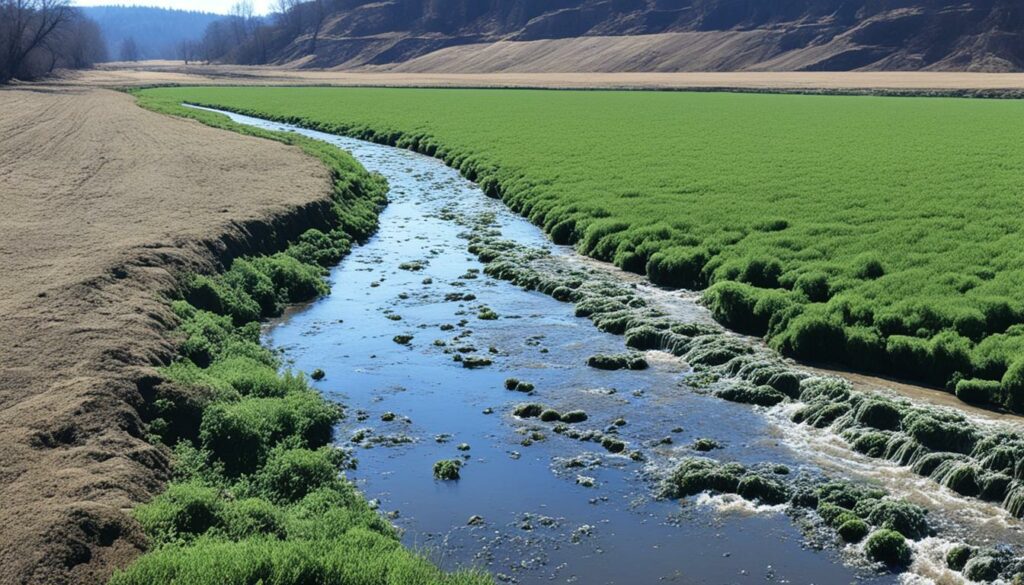
Looking at the site’s risks is vital to stopping nutrient runoff. Knowing about the land, soil, and what crops need leads to smart plans. Sediment, like dirt or silt, is a top water pollutant in North Carolina, showing the need for special erosion control.
In North Carolina, farmers often use liquid nitrogen because it works well in the warm weather. If they don’t use it right, up to half can be wasted. Phosphorus is another problem. It doesn’t move quickly, but water can carry it away, harming rivers and lakes.
By keeping an eye on nutrients and using smart plans, we help farms grow and protect the environment.
Assessing and using fertilisers well are key for good nutrient management. A solid soil testing system is the base for this. Regular soil tests find out about the soil’s nutrient-supplying capacity and other features. This info is needed to pick the right fertilizer for growing crops. Doing this right helps keep farming healthy for the long term and protects the environment.
I follow the “Four Rs” when I use fertilisers. This means I check how much to use, what type, the best way to use them, and when to put them on the fields. By doing this, plants get the most out of the nutrients. This boosts how much the crops produce and how much money they can make.
Plants need important nutrients like nitrogen, potassium, and phosphorus to grow. But, too much of these can harm the environment. So, it’s vital to use them carefully. I add things like cover crops, compost, or manure to the soil. This makes the soil better without using only chemicals.
Groups like UC SAREP and UC Cooperative Extension have lots of helpful info for farmers. For big farmers, the UC Division of Agriculture offers details just for their crops. The UC Davis California Soil Resource Lab also gives info on soils to help with fertiliser use.
| Factor | Details |
|---|---|
| Soil Testing Frequency | At least every three years |
| Key Nutrients | Nitrogen (N), Phosphorus (P), Potassium (K) |
| Methods | Incorporation of organic matter, cover crops, proper timing and rate of application |
| Resources | UC SAREP, UC Cooperative Extension, UC ANR, UC Davis California Soil Resource Lab |
Soil tests suggest how much and what kind of fertilizer crops need, depending on the soil’s actual nutrients. This smart approach helps farmers get better harvests and keep the soil rich. I believe understanding soil test results is key to using nutrients well. This way, farming stays good for the land, smart, and profitable.
Effective soil nutrient management is key for farming that lasts. The USDA suggests using the right mix of commercial fertilisers, manure, and other organic products. This improves the land for farming, making it a key part of today’s farming methods. The Four Rs approach helps by telling us to use the right amount, type, place, and time of nutrients. This boosts soil quality and helps plants grow more, all while saving costs and protecting the environment.
Soil tests are vital for success. They show the soil’s nutrients and what kind of soil it is. This helps farmers choose wisely for better crops and more profit. Important nutrients like nitrogen and phosphorus are managed carefully to support strong farm life. Farming techniques like adding cover crops and compost are great for the soil. They improve the soil’s health and make more nutrients available. Support from UC SAREP and the UC ANR’s Nutrient Management website is there for farmers to use.
Using these smart methods, farmers can keep soil in its best shape. They check and adjust the pH levels, pick the right fertiliser, and use ways that fit their farm’s needs. This keeps crops healthy now and the land fertile for the future. Looking ahead, handling soil nutrients right will continue to be crucial for farming well, protecting soil, and growing good crops. This lets us build a farming tradition that lasts for generations.
Soil nutrient management is about how we use different nutrient sources on farm fields. This includes things like commercial fertilisers and organic waste. The goal is to help crops grow well without harming the environment.
Nutrient management is key for making sure crops get the right amount of nutrients. This boosts growth while keeping the environment healthy. It’s a big part of sustainable farming, helping soil stay fertile and crops grow better.
The Four Rs stand for the right amount, right source, right placement, and right time to apply nutrients. Using this approach helps farmers use nutrients more effectively. It cuts down on waste and protects the environment.
To check soil health, you can do tests on your own or get a professional to do it. These tests show what nutrients your soil lacks. Knowing this helps you add the right stuff to make your crops do better.
Good soil health means it can hold water well, is the right pH level, and has plenty of organic matter. These things make the soil good for plants to grow in. They also make a home for helpful soil organisms.
To make a nutrient budget, look at all the nutrient sources you have. This includes both natural and bought nutrients. Think about what your crops need. This helps you use nutrients well to keep your soil healthy.
If crops lack nutrients, you’ll see their leaves turning yellow or they might not grow as they should. Each nutrient shortage shows different signs on plants. Recognising these signs can help you give your plants what they need.
To change soil pH, use lime to make it less acidic, or sulphur to make it more acidic. The right pH level helps plants get the nutrients they need. This is key for healthy crop growth.
Adding organic matter like compost helps soil keep its shape and feeds good bacteria in it. It also holds onto nutrients for plants. Growing cover crops can do the same while stopping soil erosion.
To keep nutrients in your soil, use good practices for stopping erosion and watering your fields. This stops nutrients from washing away. It’s important for keeping your crops healthy and protecting water systems.
Climate-smart farming means using nutrients wisely to cut down on climate change and cope with its effects. This includes watering fields well, looking after soil, and using fertilisers in a way that keeps the farm strong.
Handling nitrogen well is critical for crop health and protecting the environment. Knowing how to use nitrogen safely and how to stop it from harming the ecosystem is vital. It’s about farming smart to keep the environment safe.
To stop nutrient runoff, use the best practices and keep soil from eroding. Assess the risk for your land. This helps plan how to protect the environment and keep your fields productive.